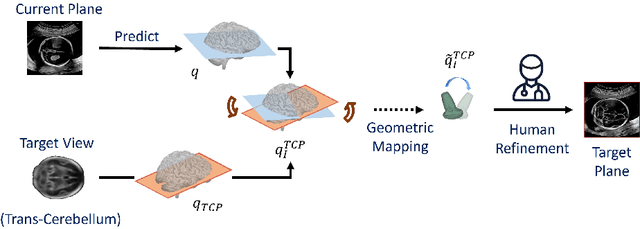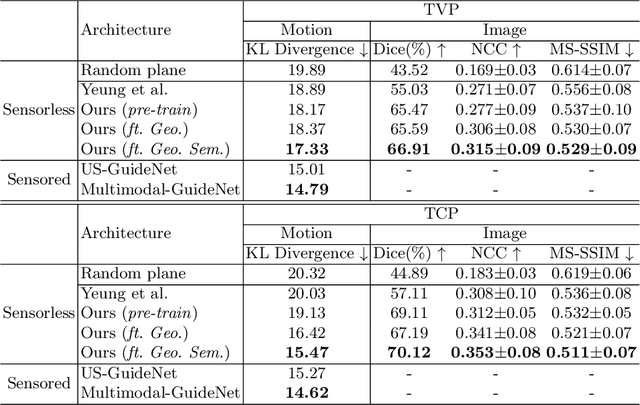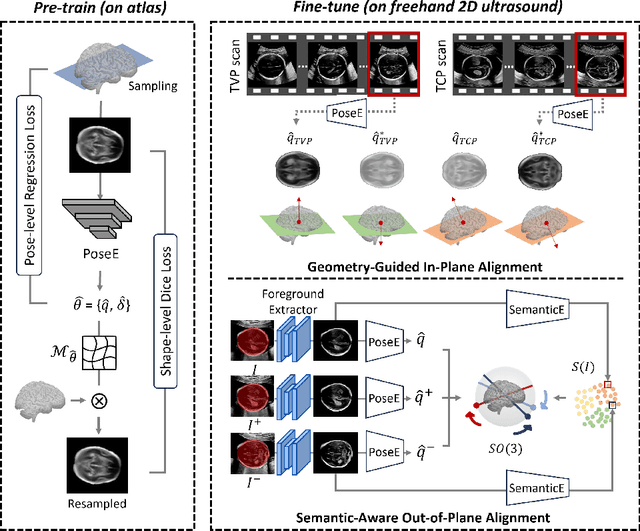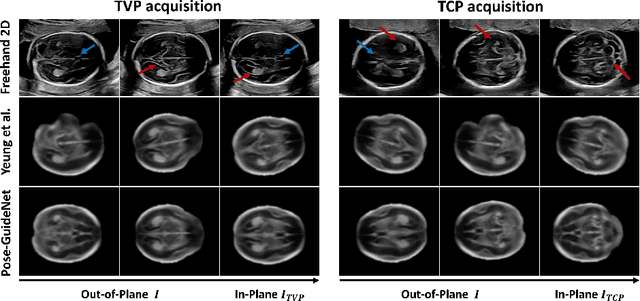J. Alison Noble
Self-supervised Learning of Echocardiographic Video Representations via Online Cluster Distillation
Jun 13, 2025Abstract:Self-supervised learning (SSL) has achieved major advances in natural images and video understanding, but challenges remain in domains like echocardiography (heart ultrasound) due to subtle anatomical structures, complex temporal dynamics, and the current lack of domain-specific pre-trained models. Existing SSL approaches such as contrastive, masked modeling, and clustering-based methods struggle with high intersample similarity, sensitivity to low PSNR inputs common in ultrasound, or aggressive augmentations that distort clinically relevant features. We present DISCOVR (Distilled Image Supervision for Cross Modal Video Representation), a self-supervised dual branch framework for cardiac ultrasound video representation learning. DISCOVR combines a clustering-based video encoder that models temporal dynamics with an online image encoder that extracts fine-grained spatial semantics. These branches are connected through a semantic cluster distillation loss that transfers anatomical knowledge from the evolving image encoder to the video encoder, enabling temporally coherent representations enriched with fine-grained semantic understanding. Evaluated on six echocardiography datasets spanning fetal, pediatric, and adult populations, DISCOVR outperforms both specialized video anomaly detection methods and state-of-the-art video-SSL baselines in zero-shot and linear probing setups, and achieves superior segmentation transfer.
DIsoN: Decentralized Isolation Networks for Out-of-Distribution Detection in Medical Imaging
Jun 10, 2025Abstract:Safe deployment of machine learning (ML) models in safety-critical domains such as medical imaging requires detecting inputs with characteristics not seen during training, known as out-of-distribution (OOD) detection, to prevent unreliable predictions. Effective OOD detection after deployment could benefit from access to the training data, enabling direct comparison between test samples and the training data distribution to identify differences. State-of-the-art OOD detection methods, however, either discard training data after deployment or assume that test samples and training data are centrally stored together, an assumption that rarely holds in real-world settings. This is because shipping training data with the deployed model is usually impossible due to the size of training databases, as well as proprietary or privacy constraints. We introduce the Isolation Network, an OOD detection framework that quantifies the difficulty of separating a target test sample from the training data by solving a binary classification task. We then propose Decentralized Isolation Networks (DIsoN), which enables the comparison of training and test data when data-sharing is impossible, by exchanging only model parameters between the remote computational nodes of training and deployment. We further extend DIsoN with class-conditioning, comparing a target sample solely with training data of its predicted class. We evaluate DIsoN on four medical imaging datasets (dermatology, chest X-ray, breast ultrasound, histopathology) across 12 OOD detection tasks. DIsoN performs favorably against existing methods while respecting data-privacy. This decentralized OOD detection framework opens the way for a new type of service that ML developers could provide along with their models: providing remote, secure utilization of their training data for OOD detection services. Code will be available upon acceptance at: *****
MCAT: Visual Query-Based Localization of Standard Anatomical Clips in Fetal Ultrasound Videos Using Multi-Tier Class-Aware Token Transformer
Apr 08, 2025Abstract:Accurate standard plane acquisition in fetal ultrasound (US) videos is crucial for fetal growth assessment, anomaly detection, and adherence to clinical guidelines. However, manually selecting standard frames is time-consuming and prone to intra- and inter-sonographer variability. Existing methods primarily rely on image-based approaches that capture standard frames and then classify the input frames across different anatomies. This ignores the dynamic nature of video acquisition and its interpretation. To address these challenges, we introduce Multi-Tier Class-Aware Token Transformer (MCAT), a visual query-based video clip localization (VQ-VCL) method, to assist sonographers by enabling them to capture a quick US sweep. By then providing a visual query of the anatomy they wish to analyze, MCAT returns the video clip containing the standard frames for that anatomy, facilitating thorough screening for potential anomalies. We evaluate MCAT on two ultrasound video datasets and a natural image VQ-VCL dataset based on Ego4D. Our model outperforms state-of-the-art methods by 10% and 13% mIoU on the ultrasound datasets and by 5.35% mIoU on the Ego4D dataset, using 96% fewer tokens. MCAT's efficiency and accuracy have significant potential implications for public health, especially in low- and middle-income countries (LMICs), where it may enhance prenatal care by streamlining standard plane acquisition, simplifying US-based screening, diagnosis and allowing sonographers to examine more patients.
IterMask3D: Unsupervised Anomaly Detection and Segmentation with Test-Time Iterative Mask Refinement in 3D Brain MR
Apr 07, 2025Abstract:Unsupervised anomaly detection and segmentation methods train a model to learn the training distribution as 'normal'. In the testing phase, they identify patterns that deviate from this normal distribution as 'anomalies'. To learn the `normal' distribution, prevailing methods corrupt the images and train a model to reconstruct them. During testing, the model attempts to reconstruct corrupted inputs based on the learned 'normal' distribution. Deviations from this distribution lead to high reconstruction errors, which indicate potential anomalies. However, corrupting an input image inevitably causes information loss even in normal regions, leading to suboptimal reconstruction and an increased risk of false positives. To alleviate this, we propose IterMask3D, an iterative spatial mask-refining strategy designed for 3D brain MRI. We iteratively spatially mask areas of the image as corruption and reconstruct them, then shrink the mask based on reconstruction error. This process iteratively unmasks 'normal' areas to the model, whose information further guides reconstruction of 'normal' patterns under the mask to be reconstructed accurately, reducing false positives. In addition, to achieve better reconstruction performance, we also propose using high-frequency image content as additional structural information to guide the reconstruction of the masked area. Extensive experiments on the detection of both synthetic and real-world imaging artifacts, as well as segmentation of various pathological lesions across multiple MRI sequences, consistently demonstrate the effectiveness of our proposed method.
Federated Continual 3D Segmentation With Single-round Communication
Mar 19, 2025Abstract:Federated learning seeks to foster collaboration among distributed clients while preserving the privacy of their local data. Traditionally, federated learning methods assume a fixed setting in which client data and learning objectives remain constant. However, in real-world scenarios, new clients may join, and existing clients may expand the segmentation label set as task requirements evolve. In such a dynamic federated analysis setup, the conventional federated communication strategy of model aggregation per communication round is suboptimal. As new clients join, this strategy requires retraining, linearly increasing communication and computation overhead. It also imposes requirements for synchronized communication, which is difficult to achieve among distributed clients. In this paper, we propose a federated continual learning strategy that employs a one-time model aggregation at the server through multi-model distillation. This approach builds and updates the global model while eliminating the need for frequent server communication. When integrating new data streams or onboarding new clients, this approach efficiently reuses previous client models, avoiding the need to retrain the global model across the entire federation. By minimizing communication load and bypassing the need to put unchanged clients online, our approach relaxes synchronization requirements among clients, providing an efficient and scalable federated analysis framework suited for real-world applications. Using multi-class 3D abdominal CT segmentation as an application task, we demonstrate the effectiveness of the proposed approach.
Self-supervised Normality Learning and Divergence Vector-guided Model Merging for Zero-shot Congenital Heart Disease Detection in Fetal Ultrasound Videos
Mar 10, 2025Abstract:Congenital Heart Disease (CHD) is one of the leading causes of fetal mortality, yet the scarcity of labeled CHD data and strict privacy regulations surrounding fetal ultrasound (US) imaging present significant challenges for the development of deep learning-based models for CHD detection. Centralised collection of large real-world datasets for rare conditions, such as CHD, from large populations requires significant co-ordination and resource. In addition, data governance rules increasingly prevent data sharing between sites. To address these challenges, we introduce, for the first time, a novel privacy-preserving, zero-shot CHD detection framework that formulates CHD detection as a normality modeling problem integrated with model merging. In our framework dubbed Sparse Tube Ultrasound Distillation (STUD), each hospital site first trains a sparse video tube-based self-supervised video anomaly detection (VAD) model on normal fetal heart US clips with self-distillation loss. This enables site-specific models to independently learn the distribution of healthy cases. To aggregate knowledge across the decentralized models while maintaining privacy, we propose a Divergence Vector-Guided Model Merging approach, DivMerge, that combines site-specific models into a single VAD model without data exchange. Our approach preserves domain-agnostic rich spatio-temporal representations, ensuring generalization to unseen CHD cases. We evaluated our approach on real-world fetal US data collected from 5 hospital sites. Our merged model outperformed site-specific models by 23.77% and 30.13% in accuracy and F1-score respectively on external test sets.
FedPIA -- Permuting and Integrating Adapters leveraging Wasserstein Barycenters for Finetuning Foundation Models in Multi-Modal Federated Learning
Dec 19, 2024Abstract:Large Vision-Language Models typically require large text and image datasets for effective fine-tuning. However, collecting data from various sites, especially in healthcare, is challenging due to strict privacy regulations. An alternative is to fine-tune these models on end-user devices, such as in medical clinics, without sending data to a server. These local clients typically have limited computing power and small datasets, which are not enough for fully fine-tuning large VLMs on their own. A naive solution to these scenarios is to leverage parameter-efficient fine-tuning (PEFT) strategies and apply federated learning (FL) algorithms to combine the learned adapter weights, thereby respecting the resource limitations and data privacy. However, this approach does not fully leverage the knowledge from multiple adapters trained on diverse data distributions and for diverse tasks. The adapters are adversely impacted by data heterogeneity and task heterogeneity across clients resulting in suboptimal convergence. To this end, we propose a novel framework called FedPIA that improves upon the naive combinations of FL and PEFT by introducing Permutation and Integration of the local Adapters in the server and global Adapters in the clients exploiting Wasserstein barycenters for improved blending of client-specific and client-agnostic knowledge. This layerwise permutation helps to bridge the gap in the parameter space of local and global adapters before integration. We conduct over 2000 client-level experiments utilizing 48 medical image datasets across five different medical vision-language FL task settings encompassing visual question answering as well as image and report-based multi-label disease detection. Our experiments involving diverse client settings, ten different modalities, and two VLM backbones demonstrate that FedPIA consistently outperforms the state-of-the-art PEFT-FL baselines.
F$^3$OCUS -- Federated Finetuning of Vision-Language Foundation Models with Optimal Client Layer Updating Strategy via Multi-objective Meta-Heuristics
Nov 17, 2024



Abstract:Effective training of large Vision-Language Models (VLMs) on resource-constrained client devices in Federated Learning (FL) requires the usage of parameter-efficient fine-tuning (PEFT) strategies. To this end, we demonstrate the impact of two factors \textit{viz.}, client-specific layer importance score that selects the most important VLM layers for fine-tuning and inter-client layer diversity score that encourages diverse layer selection across clients for optimal VLM layer selection. We first theoretically motivate and leverage the principal eigenvalue magnitude of layerwise Neural Tangent Kernels and show its effectiveness as client-specific layer importance score. Next, we propose a novel layer updating strategy dubbed F$^3$OCUS that jointly optimizes the layer importance and diversity factors by employing a data-free, multi-objective, meta-heuristic optimization on the server. We explore 5 different meta-heuristic algorithms and compare their effectiveness for selecting model layers and adapter layers towards PEFT-FL. Furthermore, we release a new MedVQA-FL dataset involving overall 707,962 VQA triplets and 9 modality-specific clients and utilize it to train and evaluate our method. Overall, we conduct more than 10,000 client-level experiments on 6 Vision-Language FL task settings involving 58 medical image datasets and 4 different VLM architectures of varying sizes to demonstrate the effectiveness of the proposed method.
Pose-GuideNet: Automatic Scanning Guidance for Fetal Head Ultrasound from Pose Estimation
Aug 19, 2024



Abstract:3D pose estimation from a 2D cross-sectional view enables healthcare professionals to navigate through the 3D space, and such techniques initiate automatic guidance in many image-guided radiology applications. In this work, we investigate how estimating 3D fetal pose from freehand 2D ultrasound scanning can guide a sonographer to locate a head standard plane. Fetal head pose is estimated by the proposed Pose-GuideNet, a novel 2D/3D registration approach to align freehand 2D ultrasound to a 3D anatomical atlas without the acquisition of 3D ultrasound. To facilitate the 2D to 3D cross-dimensional projection, we exploit the prior knowledge in the atlas to align the standard plane frame in a freehand scan. A semantic-aware contrastive-based approach is further proposed to align the frames that are off standard planes based on their anatomical similarity. In the experiment, we enhance the existing assessment of freehand image localization by comparing the transformation of its estimated pose towards standard plane with the corresponding probe motion, which reflects the actual view change in 3D anatomy. Extensive results on two clinical head biometry tasks show that Pose-GuideNet not only accurately predicts pose but also successfully predicts the direction of the fetal head. Evaluations with probe motions further demonstrate the feasibility of adopting Pose-GuideNet for freehand ultrasound-assisted navigation in a sensor-free environment.
TextCAVs: Debugging vision models using text
Aug 16, 2024Abstract:Concept-based interpretability methods are a popular form of explanation for deep learning models which provide explanations in the form of high-level human interpretable concepts. These methods typically find concept activation vectors (CAVs) using a probe dataset of concept examples. This requires labelled data for these concepts -- an expensive task in the medical domain. We introduce TextCAVs: a novel method which creates CAVs using vision-language models such as CLIP, allowing for explanations to be created solely using text descriptions of the concept, as opposed to image exemplars. This reduced cost in testing concepts allows for many concepts to be tested and for users to interact with the model, testing new ideas as they are thought of, rather than a delay caused by image collection and annotation. In early experimental results, we demonstrate that TextCAVs produces reasonable explanations for a chest x-ray dataset (MIMIC-CXR) and natural images (ImageNet), and that these explanations can be used to debug deep learning-based models.
 Add to Chrome
Add to Chrome Add to Firefox
Add to Firefox Add to Edge
Add to Edge